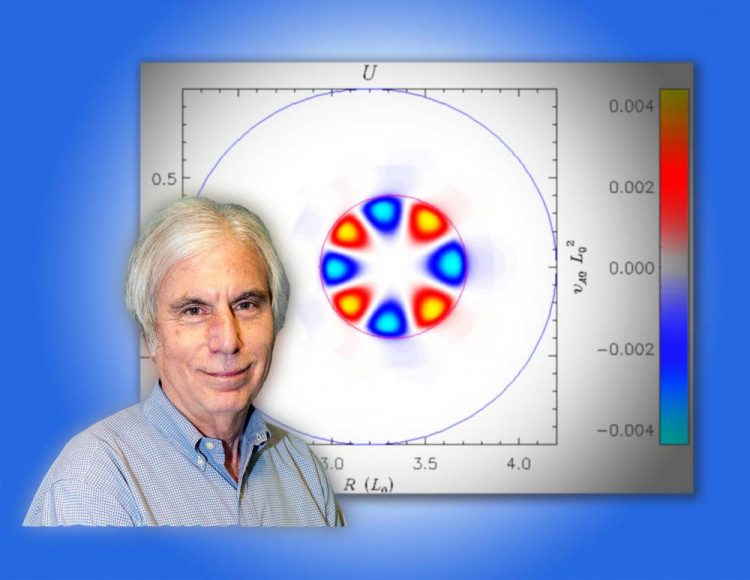New explanation for sudden heat collapses in plasmas can help create fusion energy

PPPL physicist Stephen Jardin with figure from paper. Photo and composite by Elle Starkman/PPPL Office of Communications.
Consistent with observations
Researchers at the U.S. Department of Energy's (DOE) Princeton Plasma Physics Laboratory (PPPL) have proposed a new theory to explain the swings that occur in doughnut-shaped tokamaks, or fusion facilities. The theory, created through high-fidelity computer simulations, appears consistent with observations made during tokamak experiments, the researchers said.
Understanding the process could prove vital to next-generation fusion facilities such as ITER, the international experiment under construction in France to demonstrate the practicality of fusion power.
Fusion combines light elements in the form of plasma — the hot, charged state of matter composed of free electrons and atomic nuclei — that generates massive amounts of energy. Scientists seeking to replicate fusion on Earth intend to provide a virtually inexhaustible supply of safe and clean power to generate electricity.
The recent findings demonstrate that when the pressure in the core of the plasma reaches a certain point, other instabilities can be excited that produce the sudden pressure and temperature drops.
These instabilities create jumbled — or stochastic — magnetic fields in the core of the plasma that cause the collapse, said physicist Stephen Jardin, lead author of a paper describing the process in Physics of Plasmas and highlighted in a featured American Institute of Physics publication called “SciLight.”
“Most tokamak discharges exhibit sawteeth,” Jardin said, “and we're trying to provide the theory of the physics behind them.”
The new findings depart sharply from a long-held theory that causing the swings is an instability that leads to magnetic reconnection — the breaking apart and snapping together of the magnetic field lines in plasma. “That theory has been around for over 40 years,” Jardin said.
Motivating the new theory
Motivating the new theory is previous PPPL research that demonstrates how the instability that was thought to lead to magnetic reconnection can, in fact, self-stabilize the plasma. It does this by producing a localized voltage that prevents the current in the core of the plasma from peaking sufficiently to be subject to magnetic reconnection.
The new explanation holds that even though the magnetic reconnection is suppressed, an increase of heat in the core of the plasma can excite localized instabilities that act together to flatten the pressure and temperature during the sawtooth cycle.
Simulations produced by codes developed by Jardin and PPPL physicist Nate Ferraro, a coauthor of the paper, demonstrate this process. The new instabilities can grow very fast, consistent with the rapid collapse of heat seen in experiments that the traditional theory cannot explain.
This advanced model provides a new way to understand sawtooth phenomena. Looking ahead, the scientists want to explore the applicability of the model to tasks such as describing the evolution of “monster sawteeth” and using high powered Radio Frequency antennas to control sawtooth swings. “We want to develop a simulation model of a whole tokamak plasma,” Jardin said, “and this new theory of the sawteeth is an important part of the effort.”
###
Coauthors of the paper include Isabel Krebs, a former post-doctoral physicist at PPPL now at the Dutch Institute for Fundamental Energy Research (DIFFER), who developed the theory that the instability thought to cause temperature collapse could serve to stabilize the plasma. Support for the new research comes from the DOE Office of Science and the SciDAC Center for Tokamak Transient Simulations. Researchers developed the new simulations at the National Energy Research Scientific Computing Center (NERSC), a DOE Office of Science User Facility at Lawrence Berkeley National Laboratory.
PPPL, on Princeton University's Forrestal Campus in Plainsboro, N.J., is devoted to creating new knowledge about the physics of plasmas — ultra-hot, charged gases — and to developing practical solutions for the creation of fusion energy. The Laboratory is managed by the University for the U.S. Department of Energy's Office of Science, which is the single largest supporter of basic research in the physical sciences in the United States and is working to address some of the most pressing challenges of our time. For more information, visit energy.gov/science.
Media Contact
All latest news from the category: Power and Electrical Engineering
This topic covers issues related to energy generation, conversion, transportation and consumption and how the industry is addressing the challenge of energy efficiency in general.
innovations-report provides in-depth and informative reports and articles on subjects ranging from wind energy, fuel cell technology, solar energy, geothermal energy, petroleum, gas, nuclear engineering, alternative energy and energy efficiency to fusion, hydrogen and superconductor technologies.
Newest articles

Bringing bio-inspired robots to life
Nebraska researcher Eric Markvicka gets NSF CAREER Award to pursue manufacture of novel materials for soft robotics and stretchable electronics. Engineers are increasingly eager to develop robots that mimic the…

Bella moths use poison to attract mates
Scientists are closer to finding out how. Pyrrolizidine alkaloids are as bitter and toxic as they are hard to pronounce. They’re produced by several different types of plants and are…

AI tool creates ‘synthetic’ images of cells
…for enhanced microscopy analysis. Observing individual cells through microscopes can reveal a range of important cell biological phenomena that frequently play a role in human diseases, but the process of…





















